

20 Master Plots and How to Build Them. The Six Main Stories, As Identified by a Computer - The Atlantic. “My prettiest contribution to my culture,” the writer Kurt Vonnegut mused in his 1981 autobiography Palm Sunday, “was a master’s thesis in anthropology which was rejected by the University of Chicago a long time ago.”

By then, he said, the thesis had long since vanished. (“It was rejected because it was so simple and looked like too much fun,” Vonnegut explained.) But he continued to carry the idea with him for many years after that, and spoke publicly about it more than once. It was, essentially, this: “There is no reason why the simple shapes of stories can’t be fed into computers. They are beautiful shapes.” That explanation comes from a lecture he gave, and which you can still watch on YouTube, that involves Vonnegut mapping the narrative arc of popular storylines along a simple graph. The most interesting shape to him, it turned out, was the one that reflected the tale of Cinderella, of all stories. 1. 2. 3. 4. 5. 6. First, the researchers had to find a workable dataset.
Plotting With Layers: 4 Steps to a Stronger Plot. By Janice Hardy, @Janice_Hardy This week's Refresher Friday takes a heavily updated look at why plots are like houses, and how "building" with layers will help you create stronger plots.
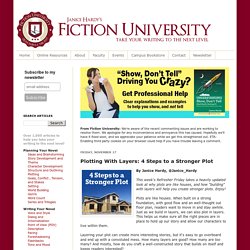
Enjoy! Plots are like houses. Kurt Vonnegut on the Shapes of Stories. List of narrative techniques - Wikipedia. A narrative technique (also known more narrowly for literary fictional narratives as a literary technique, literary device, or fictional device) is any of several specific methods the creator of a narrative uses to convey what they want[1]—in other words, a strategy used in the making of a narrative to relay information to the audience and, particularly, to "develop" the narrative, usually in order to make it more complete, complicated, or interesting.

Literary techniques are distinguished from literary elements, which exist inherently in works of writing. Setting[edit] Plots[edit] Perspective[edit] Style[edit] Theme[edit] Character[edit] References[edit] ^ Orehovec, Barbara (2003). Ideas and Plots. Murphy's Law Gen. Elements of Suspense in Writing: 6 Secret to Creating and Sustaining Suspense. Thriller writing?
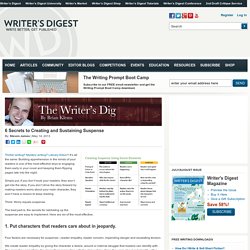
Mystery writing? Literary fiction? It’s all the same: Building apprehension in the minds of your readers is one of the most effective keys to engaging them early in your novel and keeping them flipping pages late into the night. Simply put, if you don’t hook your readers, they won’t get into the story. The Art of Conflict by Rachael Thomas. Happy Monday!

Rachael Thomas explains why conflict plays a crucial role in a story. Every story needs conflict, but what exactly is conflict and why does it matter in romance? Conflict is an incompatibility between the objectives of your characters and is needed because it creates tension in your story. In short, it’s what keeps your characters apart emotionally despite the physical attraction they have for each other. A character with a believable conflict will keep the reader turning those pages to see what happens next.
Raising the Stakes: Revising to Keep Readers Reading. When you first write a draft you might not worry too much about why your protagonist is doing what she’s doing.
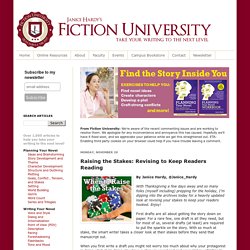
You have a story in your head and your plot is unfolding to that mental picture. But crafting a compelling novel is about more than just telling a story. It’s making a reader want to read that story. The Subplot - Not Second Place, but Side by Side. There is one element in plotting our story that we sometimes forget or neglect—the subplot.
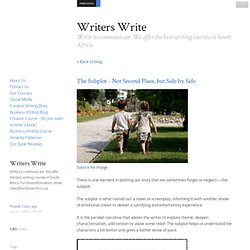
The subplot is what rounds out a novel or screenplay, informing it with another shade of emotional colour to deliver a satisfying and entertaining experience. It is the parallel narrative that allows the writer to explore theme, deepen characterisation, add tension or allow some relief. The subplot helps us understand the characters a bit better and gives a better sense of pace. Love and other pursuits. Let’s ditch the dangerous idea that life is a story ... ‘Each of us constructs and lives a “narrative”,’ wrote the British neurologist Oliver Sacks, ‘this narrative is us’.

Likewise the American cognitive psychologist Jerome Bruner: ‘Self is a perpetually rewritten story.’ And: ‘In the end, we become the autobiographical narratives by which we “tell about” our lives.’ Or a fellow American psychologist, Dan P McAdams: ‘We are all storytellers, and we are the stories we tell.’ And here’s the American moral philosopher J David Velleman: ‘We invent ourselves… but we really are the characters we invent.’ And, for good measure, another American philosopher, Daniel Dennett: ‘we are all virtuoso novelists, who find ourselves engaged in all sorts of behaviour… and we always put the best “faces” on it we can. So say the narrativists. Narrative Editors. Plot Generator. GATE Websites and Articles. Real Life Diagnostics: Diagnosing a Story Idea. Critique By Janice Hardy, @Janice_Hardy Real Life Diagnostics is a weekly column that studies a snippet of a work in progress for specific issues.
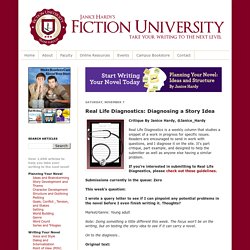
Readers are encouraged to send in work with questions, and I diagnose it on the site. It’s part critique, part example, and designed to help the submitter as well as anyone else having a similar problem. If you're interested in submitting to Real Life Diagnostics, please check out these guidelines. Submissions currently in the queue: Zero. And the Pace is On: Understanding and Controlling Your Pacing. By Janice Hardy, @Janice_Hardy My husband isn't a YA reader (though I'm trying to change that) and when he read my book for the first time, one of his comments was: "Wow, you do stuff in three pages that would take an adult book three chapters.
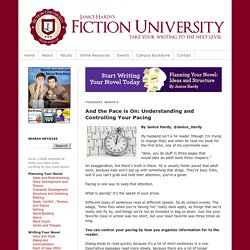
" Move Along: Fixing Pacing Problems. By Janice Hardy, @Janice_Hardy Pacing problems fall into two categories: too slow or too fast. While this makes it easy to diagnose the trouble, it takes a bit more to solve the actual problem. Too slow can be an editing issue, a stakes issue, or even a structure issue. Real Life Diagnostics: Fixing Your Pacing and Narrative Flow. Critique By Janice Hardy, @Janice_Hardy Real Life Diagnostics is a weekly column that studies a snippet of a work in progress for specific issues.
Readers are encouraged to send in work with questions, and I diagnose it on the site. It’s part critique, part example, and designed to help the submitter as well as anyone else having a similar problem. If you're interested in submitting to Real Life Diagnostics, please check out these guidelines. Submissions currently in the queue: One. NaNoWriMo Prep: Planning Your Novel’s Middle. By Janice Hardy, @Janice_Hardy It’s middle time! Middles just might be the most common tough spot for writers, and with good reason. Beatsheets. Story Beats. Get The Story Straight. Writing Basics: The Midpoint Reversal. By Janice Hardy, @Janice_Hardy For a while now, we’ve looked at the basic of the major turning points in the Three Act Structure.
So far, we’ve discussed how the opening scene leads to the inciting event, which leads to the act one problem, and presents the protagonist with the act two choice. That choice throws the story into the middle of the novel, and will drive the protagonist to the midpoint reversal. What Are Narrative Strands? 6 Ways to Create Riveting Conflict in Your Story.
Who says conflict is a bad thing? Who says world peace is the most important goal of humanity? Who says arguing with your little brother when you’re a kid means you’ll grow up to be an ill-mannered ruffian? Not a writer, that’s for sure! Arguably, the single most important tenet of fiction can be summed up in the saw “no conflict, no story.” Elements of Suspense in Writing: 6 Secret to Creating and Sustaining Suspense. Www.writersdigest.com/wp-content/uploads/Master-Plots-Exclusive.pdf. A Handwritten Plot Outline J.K. Rowling Made While Writing ‘Harry Potter and the Order of the Phoenix’ How to Outline Your Novel. How to Make a Plot Line for a Story. How to Write a Chapter by Chapter Outline. 6 Ways to Create Riveting Conflict in Your Story. Assimilation Plot. Structure. Plot and Structure, James Scott Bell.
The Best Story Structure Tool We Know. By Glen C. Strathy Of the various story structure models or theories that exist, we have chosen to focus mainly on Dramatica, which was developed by Melanie Anne Phillips and Chris Huntley. We chose to work with this model because it is the only one that... 1. Addresses all aspects of story structure simultaneously and in an integrated way, including not just plot and character but also theme (something most models barely touch on). 2. 3. 4. What's more, Dramatica embodies certain insights into story structure that no other theory does. The aim of this website is to present practical tips and exercises to help writers, while avoiding a lot of theory. Story Structure. How to Develop Fiction Plots: 13 Steps. Edit Article. Plot Devices. The Mirror Moment: A Method for Both Plotters and Pantsers. Why "Start With the Action" Messes Up So Many Writers. '+windowtitle+' Outlining Your Novel: Create a Roadmap to Storytelling Success.
Tobias' 20 Plots. The Golden Rules for a Good Plot. The 4 Story Structures that Dominate Novels. All stories contain four elements that can determine structure: milieu, idea, character and event. While each is present in every story, there is generally one that dominates the others. Which one dominates? The one that the author cares about most. This is why the process of discovering the structure of a story is usually a process of self-discovery.
4 Ways to Write a Killer Plot Twist. How to plot a novel, Plot structure template. Novel Plotting Worksheet. Easy Novel Outline – Free Writing Lessons and Worksheets. Plot and Structure. 25 Unique Places to Find Story Ideas. Plotting. How to Let Plot Guide Your Short Story. 25 Ways To Plot, Plan and Prep Your Story. Elements of Suspense in Writing: 6 Secret to Creating and Sustaining Suspense. What is Plot - How to Write a Story from Beginning to End. Friedman's Story Plots. Plot Scenario Generator. The Thirty-Six Dramatic Situations. Plotting a Short Story. How To Write a Good Story - Creating a UNIQUE plot - Page 2.
29 Plot Templates. Get The Story Straight. Structuring Your Novel Visual Chart. The Algonkian Author Salon - A Project Source for Agents and Publishers. How To Structure A Story: The 8 Point Arc. The basic plots of fiction: Professor who analysed 40,000 novels claims there are just SIX possible storylines.